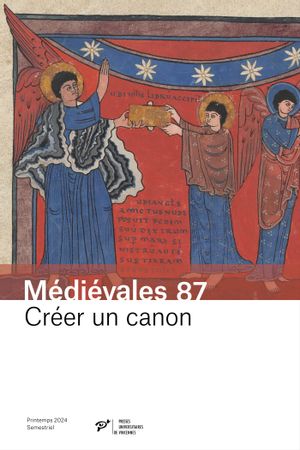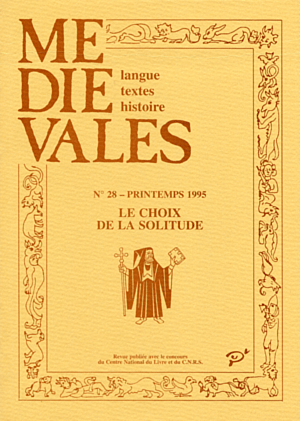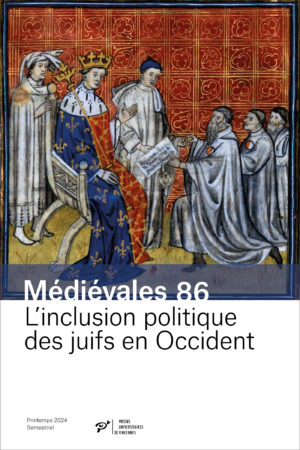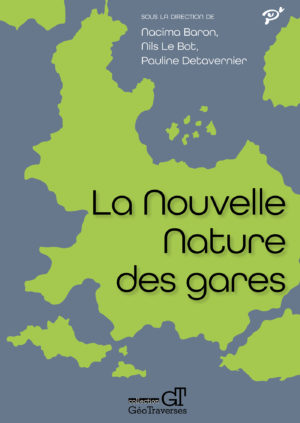Sofia BOESCH GAJANO
Terror and Torment. Forms of Hermitism in Central Italy Between the l2th and the l3th Century
The article explores two expressions of hermitism, two experiences of the holy life in the Valley of Subiaco, sanctified by the radiating influence of the Monastery of Saint Benedict. In the late eleventh century a young girl named Chelidonia settled in a remote and rugged cavern in the Simbruini mountains on the slope opposite the monastery, where she had little contact with the monastic institution but was revered by the population for her saintliness during her lifetime and for centuries to come. In the thirteenth century, the more renowned Lorenzo Loricato also settled in a cavern, but near the Sacro Speco, where Saint Benedict once lived as a hermit. Chelidonia chose to brave alone, with the help of fast and prayer, the terrors and dangers of her natural environment, on the « margins » of the monastic institution. Lorenzo chose a « protected » form of hermitism : he severely mortified his body, but to do so required the constant assistance of the monks. The story of these two saintly hermits, a man and a woman who lived a century apart, illustrates the many-sided relationship of hermitism with the monastic institution, popular worship, and nature.
Catherine SANTSCHI
The Solitude of the Hermits. An Investigation in the Alpine Regions
Were hermits really alone ? To answer this question, the author examines the different significations given to the term solitudo in a number of hermitical and monastic rules and describes the alpine landscapes where the hermits lived, as depicted in hagiographic and other texts from the High Middle Ages to the fifteenth century. It may be deduced from this study that hermitism can best be defined by the characteristic choice of arid and inhospitable retreats rather than by the fact of living alone. For various reasons of a psychological order, monastic rules prohibited total isolation, considered as a source of egotism, pride, and acedia. Indeed, in practice, the hermits often had one, if not several companions, novices, or servants. Moreover, the truly saintly attracted so many visitors that meditation, silence, and prayer were disturbed and endangered. The choice of solitude thus implies a quest for an equitable balance between consecration to the service of God alone and charity toward one’s neighbor.
Stephane DI DOMENICO
The Pull of the Mountain, the Call of the Village Franco of Assergi, Hermit of Gran Sasso (l3th century)
In the late thirteenth century, Franco of Assergi chose the steep and craggy Abruzzi mountains as a retreat to attain his ideal of the solitary life. The Benedictine monk became a hermit, and the mountain became his desert. It was, in fact, a much visited desert, where the hermit’s presence appears as a projection of the civilized world into a natural and wild expanse. After his death, the pioneer-hermit became the intercessor-saint of the village of Assergi, as well as its patron saint. AIl the anger and the anguish felt by the mountain populations transpire in the accounts of the miracles of Saint France. The popular paintings which decorate the altar dedicated to the saint and represent the different places which had been visited by him give an idea of the perception men had of these wild or civilized areas.
Mathieu ARNOUX
A Venetian in the Mont-Saint-Michiel : Anastasius, a Monk, a Hermit and a Confessor (Ý circa 1085)
The career of the hermit Anastasius is known solely from a vita written in the early twelfth century, and which was generally not very highly thought of by historians However, a comparison with other sources has attested to its credibility and thrown light upon the life of this Venitian who settled in the Mont Saint-Michel around 1023 and then lived as a hermit on the islet of Tombelaine, from where he followed Hugh of Semur to Cluny before leaving for the Pyrenees, where he continued his hermitical life and where he died around 1085. Like other Italian clerics, and particularly Anselm who was his friend, he played an important rôle in the Norman church, and took part in the eucharistic controversy by writing a short treatise, his only extant work. His origins, his eventfuI existence, and his predisposition for the solitary life make him a true disciple of Saint Romuald, who had such a profound influence on the Venitian church. Anastasius’s presence in Normandy, probably on William of Volpiano’s instigation, and subsequently his commitment to the Clunisians, confirm the spreading influence of the hermetic and monastic movement beyond Italy, where it originated.
Cécile CABY
Hermitism and inurbamento in the Camaldulensian Order in the Late Middle Ages
Several Camaldulensian establishments founded in the thirteenth and fourteenth centuries put into practice the hermitical model of Camaldoli, thus creating a movement of observance. Although the Camaldulensian constitu-tions, elaborated in the twelfth century and completed in the last three decades of the thirteenth, expound a rule of life for the hermits, they give no clear indication as to the practical application of the observance. The abundant documentation preserved to us concerning the Florentine hermitage of Santa Maria degli Angeli offers an enlightening day-to-day picture of Camaldulensian hermitism. Founded toward the very end of the thirteenth century, this urban hermitage exemplified a form of open reclusion much in favor with Florentine society and especially with the chancellor Coluccio Salu tati. But the fragile compromise between hermitism and urban life became evident in the early years of the fifteenth century when the community split and the schismatic group founded a new hermitage : a sign that the return to observance in the Camaldulensian order continued to be perceived as a return to hermitism.
Lucie GERNEZ
Relics and Images of Saint Galgano in Siena (l3th-l4th centuries)
In the late twelfth century, thirty kilometers to the southwest of Siena, near the confines of the Maremma, Galgano Guidotti, a knight from Chiusdino, plunged his sword into the rock of Mount Siepi in the manner of a cross and chose to live as a hermit After his death Mount Siepi became a popular center of worship where the faithful came to venerate the relics of the saintly hermit. The newly-founded cuIt inspired artists and the iconographic cycle of the saint’s life engraved on the reliquary enclosing his head was soon echoed in paintings by artists such as Andrea di Bartolo, Vecchietta, and Giovanni di Paolo. The images of the knight converted to hermitism also found favor with the ruling circles of the Commune of Siena, who conjugated its efforts with those of the Abbey of San Galgano to promote the cult of the saint and integrate him into the pantheon of the city’s protectors.
Élizabeth HALNA-KLEIN
On the Traces of the Lynx
Through the ages, the lynx lived in the forests and mountains of Europe, but its relationship to man remained ambiguous. Already present in Greek and Roman mythology and scientific treatises, during the Middle Ages the lynx was often perceived as an evil, diabolical and jealous animal, useless to its environment and to man. It inspired man’s imagination and was thought for example to bury its urine in the carth, where it was transformed into carbuncles. Mysterious and misunderstood, its classification was uncertain and it was most often assimilated into the wolf family. Yet Gaston Phébus classes the lynx with the felids and Hildegard of Bingen considers it as a positive, independent and useful animal. Hunted and trapped for its fur, the lynx had aIl but disappeared from Europe by the end of the nineteenth century. Today the lynx is better known, but its reintroduction into its natural habitat in Western Europe stilI gives rise to contradiction and controversy.
Simone ROUX
Limits and Boundary Stones in Paris in the Later Middle Ages
Among the boundaries which demarcated the various social areas inside the city walls of Paris in the later Middle Ages, those pertaining to seigniorial territories, called « censives », had a particularly important significance for most Parisians. These limits indicated by boundary stones and signs on houses, determined the geography of the system of the land administration and designated on which eminent Iandowner’s property each building was situated. More than other limits, those of the « censives » have left evidence in the written records of the important part they played in the daily life of the capital.






